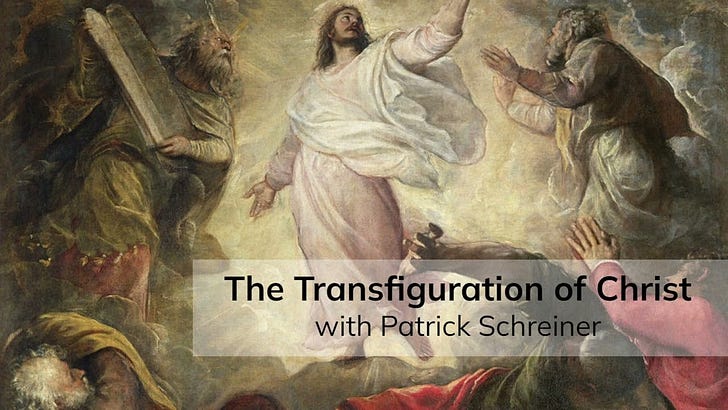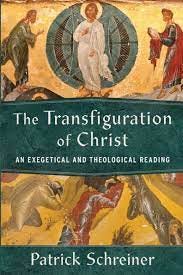Patrick Schreiner
The Transfiguration of Christ: An Exegetical and Theological Reading
Grand Rapids, MI: Baker, 2024.
Books on Jesus’s ascension are rare, books on the transfiguration of Jesus are rarer still!
Accordingly, Schreiner’s volume is much needed for a much-neglected topic and he does not disappoint.
Schreiner maps the transfiguration in relationship to Jesus’s career, biblical themes, and other Christian doctrines. His purpose is to show through a theological reading that Jesus’s transfiguration is an unveiling of his pre-existent glory and presages the progressive conformity of the Christian into the glory of God where we behold “God’s glory in the face of Jesus Christ’ (2 Corinthians 4:6) and “see him as he is” (1 John 3:2) (xiv).
Schreiner contends that the transfiguration conveys Jesus’s double sonship. The transfiguration reveals “both the future glory of the earthly and suffering messianic Son and the preexistent glory of the heavenly and eternally begotten Son” (4). The luminous spectacularity of the transfiguration is proof that Jesus is from God as “light from light.” This perspective, somewhat controversially, is a resource for the early church to articulate Jesus’ ontology because “The future glory of the messianic Son is grounded in his eternally begotten nature” (5). The logic is that the transfiguration reveals God’s work ad intra as well as ad extra, ontology and mission are interconnected, for who the Son is, is premised on his prior heavenly existence and his final glorification seated at the right hand of the Father. This is a bold claim, it will not please anti-theological exegetes or comparative historians, but it is fully coherent as a theological account of the transfiguration.
The transfiguration is not only a revelation and transformation of Jesus, but also transformative for the disciples. Peter’s confession that Jesus is the Messiah, Son of the living God is confirmed; it offers divine affirmation of Jesus’s passion predictions about a glory after suffering; and the transfiguration points to God’s eternal love poured out on humanity by giving them hope of a transfigured creation.
Schreiner surveys reasons why the transfiguration is neglected such as its minor role in Scripture and creeds, disinterest by Protestants in the beatific visions, the event itself being bafflingly mysterious, people are too earthly minded and suspicious of anything that hints of theosis or “deification.” Instead, Schreiner counsels that readers of Scripture should attend to the transfiguration because it combines scriptural narrative and dogmatics, it unites the means (cross) and goal of salvation (beholding God), it pairs mystery (who is Jesus?) with revelation (he is the divine Son!), and it marries heaven to earth while foreshadowing “eschatological naturalism” where heaven and earth are fit to be united together (23).
In regard to the setting of the transfiguration, Schreiner exposits it through a fourfold method of theological exploration with attention to literal (historical), spiritual (typological), tropological (moral), and anagogical (eschatological) categories. He accordingly finds in the various details of the setting of the transfiguration – six/eight days; high mountain; and three disciples – a double meaning as to Jesus’s messianic and eternal sonship.
Concerning the signs embedded within the transfiguration story, Schreiner examines Jesus’s shining face and white clothes, the bright cloud, and the appearance of Moses and Elijah. Again, he identifies each aspect as possessing a double meaning of Jesus’s messianic and eternal sonship. In effect, Mosaic echoes underscore his role as a mediator, but also his identity as a glorious heavenly being. The scene is said to be theophanic in a fully triune sense. Moses and Elijah are old covenant representatives who prepare for the messiah and (interestingly for me) their presence is said to be there to fulfill their unfulfilled desire to see the glory of God.
As to the verbal exchanges at the transfiguration, Schreiner regards Peter’s offer to build three tents as due to Peter’s inability to grasp that Jesus’s glory must travel through the veil of suffering nor does he recognize Jesus’s supremacy over Moses and Elijah. The heavenly voice that declares “This is my beloved Son,” an obvious echo of Psalm 2:7, stresses Jesus’s Davidic and eternally begotten sonships. The command “Listen to him” underscores Jesus as a new prophet and law-giver while also emphasizing that Jesus’s words convey divine authority.
The transfiguration event is also put into relation to other doctrines by Schreiner. He situates the transfiguration in relation to creation, incarnation, it rehearses Jesus’s baptism, previews Gethsemane, foreshadows the cross, resurrection, ascent, return, and provides glimpses too of the new creation. Schreiner is eminently quotable at one point, “The cross and transfiguration are not two competing visions but two complementary pictures of the Messiah. If the rulers of this age had understood who Jesus was, they would not have crucified the Lord of glory (1 Cor. 2:8)” (139).
Schreiner’s book is a great effort to reinvigorate interest in the transfiguration. It is not merely a misplaced resurrections story (as Bultmann taught), but “a great hinge of Jesus’s life and ministry” and is the paradigmatic revelation of Jesus’s double sonship as the event is both an epiphany (because Jesus is God) and an apotheosis (because Jesus is man) (147-48).
I enjoyed the book, but readers should note that Schreiner is something of a theological maximalist when it comes to reading the transfiguration story and constructing its meanings in light of wider doctrines. Sometimes that is compelling, such as when the transfiguration previews how Jesus is “light from light,” but other times the analogies and allegories are somewhat labored. For instance, while I am optimistic about detecting intertextual echoes of Daniel 7 in the Gospels, even I had to squint and scratch my head at Schreiner’s attempt to find a preview of Jesus as the enthroned Son of Man in the transfiguration amidst some of the details he explains (32-34). Or else, when he claims that on the mountain Jesus is not only “the new Moses but the object of what Moses saw on the mountain – Yahweh himself,” I am unsure as the emphasis is on the divinely sent Son who should be obeyed, not his identification as/with/is Yahweh (36).
Those reservations aside, Schreiner has written the most detailed and robust book on the transfiguration in living memory, a book that is theologically rich, with an elegant vision of Jesus as the Lord of Glory. In effect, the book is a glorious invitation, “Come, let us go up the mountain to behold the glorious Son!” (26) and an honest prayer, “May the light of the Son flow through us” (158).





Funny this coming straight after being brought to tears on the weekend by John Dickson’s reflection on the transfiguration during one of his recent podcasts.